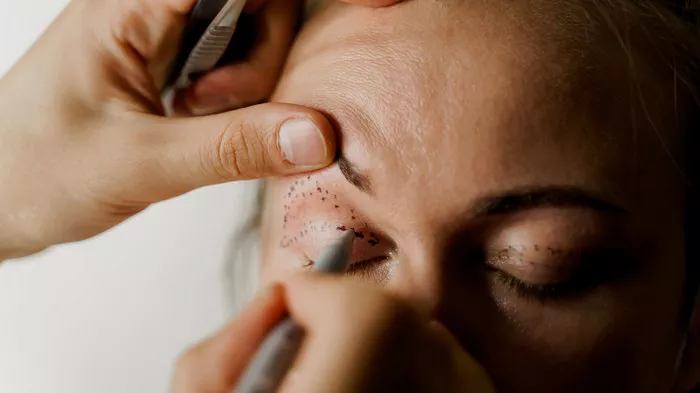Blepharoplasty, commonly known as eyelid surgery, is a cosmetic procedure that aims to enhance the appearance of the eyes by removing excess skin and fat from the eyelids. While the decision to undergo blepharoplasty is a personal one, many individuals considering this surgery are often concerned about the cost. Understanding the factors that influence the cost of blepharoplasty is crucial for anyone contemplating this procedure. In this comprehensive guide, we will explore the various elements that contribute to the price of blepharoplasty and provide valuable insights to help you make an informed decision.
I. Types of Blepharoplasty
Before delving into the cost factors, it’s essential to be aware of the different types of blepharoplasty procedures:
Upper Eyelid Blepharoplasty: This procedure focuses on rejuvenating the upper eyelids, typically addressing sagging skin and excess fat deposits.
Lower Eyelid Blepharoplasty: Lower eyelid surgery primarily targets puffiness, wrinkles, and bags under the eyes.
Double Eyelid Surgery: Common in Asian countries, double eyelid surgery creates a fold in the upper eyelid to create the appearance of a double eyelid.
Canthoplasty: This procedure adjusts the angle of the outer corner of the eyes, improving their overall shape.
II. Factors Influencing Blepharoplasty Cost
Surgeon’s Expertise and Reputation: Highly skilled and renowned surgeons often charge higher fees due to their experience and successful track records. It is crucial to research and choose a board-certified plastic surgeon with a strong reputation to ensure the best results.
Geographical Location: The cost of blepharoplasty varies significantly depending on your location. Procedures performed in major metropolitan areas with a higher cost of living typically come with a higher price tag.
Facility Fees: The choice of surgical facility plays a role in the overall cost. Hospitals generally charge more than outpatient surgical centers. The facility’s amenities and accreditation status can also influence the price.
Anesthesia Fees: Anesthesia is administered during blepharoplasty to ensure the patient’s comfort. The type of anesthesia used and the anesthesiologist’s fees will be factored into the overall cost.
Pre-operative Testing: Before surgery, patients may need various medical tests, including blood work and EKGs, to ensure their safety during the procedure. These tests can add to the overall cost.
Surgical Technique: The complexity of the surgery and the chosen technique affect the cost. More intricate procedures, such as double eyelid surgery or canthoplasty, often require more time and skill, resulting in higher fees.
Extent of Surgery: The extent of the eyelid surgery, whether upper, lower, or both, will impact the cost. Combining upper and lower eyelid surgery is generally more expensive than either procedure alone.
Additional Procedures: Patients who opt for other cosmetic procedures in conjunction with blepharoplasty, such as a facelift or brow lift, will incur additional costs.
Post-operative Care: Follow-up appointments and post-operative care may also be included in the overall price. Ensure that you understand the post-surgery care plan to manage your expectations and costs.
III. Average Cost of Blepharoplasty
The cost of blepharoplasty can vary widely, ranging from a few thousand dollars to several thousand dollars. On average, in the United States, the cost for upper eyelid surgery typically falls between $2,500 and $3,500, while lower eyelid surgery ranges from $3,000 to $4,500. When both upper and lower eyelid surgery is performed together, the cost generally ranges from $5,000 to $8,000. However, these figures can significantly change based on the factors mentioned earlier.
It’s crucial to note that these prices are for the surgeon’s fees alone and may not include facility fees, anesthesia costs, and other associated expenses. Therefore, it is essential to obtain a comprehensive quote from your chosen surgeon or surgical center.
IV. Financing Options
Understanding that blepharoplasty can be a significant financial commitment, many patients explore financing options to make the procedure more affordable:
Health Savings Accounts (HSAs) and Flexible Spending Accounts (FSAs): If your employer offers an HSA or FSA, you can use pre-tax dollars to pay for eligible medical expenses, including blepharoplasty.
Medical Credit Cards: Some credit card companies offer specialized medical credit cards with promotional financing options for cosmetic surgery procedures.
Personal Loans: Many financial institutions offer personal loans that can be used to cover the cost of elective surgeries like blepharoplasty.
Payment Plans: Some plastic surgeons and surgical centers offer in-house financing or payment plans to help patients spread the cost of their procedure over time.
Insurance Coverage: In some cases, insurance may cover a portion of the cost if the blepharoplasty is deemed medically necessary to address vision impairment caused by excess eyelid skin.
V. Conclusion
Blepharoplasty can be a life-changing procedure for individuals seeking to rejuvenate their appearance and boost their self-confidence. Understanding the factors that influence the cost of blepharoplasty is essential in making an informed decision. While the price of this cosmetic surgery can vary significantly, it’s crucial not to compromise on the quality of care and the expertise of your surgeon. Prioritize safety and results when choosing your surgeon, and explore financing options to make the procedure more accessible if needed. Ultimately, investing in the right surgeon and a successful outcome can provide long-lasting satisfaction and improved self-esteem.


